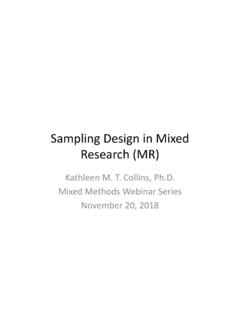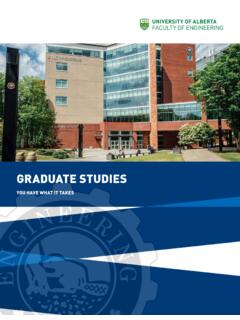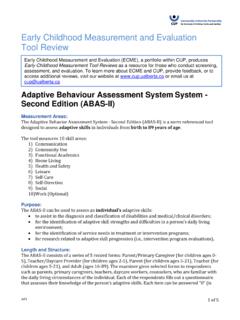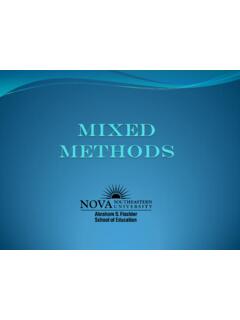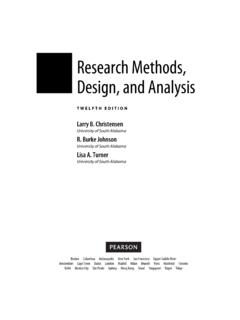Transcription of Mixed methods analysis - University of Alberta
1 Integrating Mixed methods analyses MMIRA-IIQM webinar Pat Bazeley Pat Bazeley & research Support P/L What is analysis ? Historically: analysis comes from the Ancient Greek ( analysis , "a breaking up", from ana- "up, throughout" and lysis "a loosening") The process of breaking a complex topic or substance into smaller parts in order to gain a better understanding of it An interpretive orientation to analysis All phenomena have both qualities and quantities numbers and words are both representations of phenomena All data are based on a qualitative foundation, interpreted, and then selectively rendered . If we are to be truly scientific, we must re-establish the qualitative grounding of the quantitative.
2 Donald Campbell (1974: 30) Statistics is not really about numbers; it is about understanding our world. David Howell (2014: xi) analysis , then, is a process of deconstructing and reconstructing evidence that involves interrogation of and critical thinking about data and the questions they are designed to answer in order to produce a useful and/or meaningful result. Think about data (not qual or quant) Phases of analysis (in general) Preparatory work is needed to ready the data for analysis . Explore the data, to see what is there. Manage, reduce, sort and code the data to identify relevant variables, concepts and themes. Describe what is being revealed by the data.
3 Undertake comparative analyses that answer research questions about differences and/or help to discern deeper meaning. Investigate patterns of association. Build toward interrelated thematic or explanatory/predictive statements Explore and test alternative explanations. Report results, inferences, interpretations supported by data displays (models, tables) and source evidence. Integration implies Using more than one approach, method, source of data and/or strategy for data analysis Having a common purpose or goal Interdependence of these different elements in reaching the goal Having a sum greater than the parts Integration occurs primarily through data management and analysis .
4 For MM analysis , integration is critical Approaching Mixed methods analysis See analysis as a continuation of a conversation between methods that began when the foundations of the study were laid. To make a start: What are the questions you want to answer (they might be different from those you started with)? What data you have for answering these? Think about data (not qual or quant) A theory of change for integrative Mixed methods analysis The theory of change (Do -> Get) model behind integrative Mixed methods analysis is very simple. It is that: (1)effectively combining more than one source or type of data and/or more than one approach to analysis will deliver a gain over using a single source, type of data, or approach to analysis , and (2)effective integration of sources and analyses will also deliver a gain over separate analyses of different sources.
5 A logic model for Mixed methods analysis Logic models operationalise a theory of change (Knowlton & Phillips, 2013) Pat Bazeley & research Support P/L Starting points (inputs) for integrative processes First level processes Second level processes Interpretive outcomes Applications Data bits : cases, sources, variables Preprocessed data: coded ql; descriptive qt During analysis : working ql + qt together During writing: topic/issue focus analytic reflection Sorting Coding Memoing Describing Guiding Weaving Consolidating Juxtaposing Linking Counting Transforming Interpreting, reflecting Elaborating Complementing Merging Comparing Blending Exploring Probing Questioning Testing Writing Discover Describe Confirm Refine Explain Predict Puzzle/ initiate/ resolve Basic (pure) research : advancing knowledge theory building Strategic research : policy development Applied research .
6 Needs analysis improving practice RCTs monitoring & evaluation Data preparation/preprocessing Some preprocessing is usually required involving, , coding and descriptive analyses Keep your focus on the whole dataset, and your research purposes, while doing this: it is part of the continuing conversation! Develop a habit of memoing To build an audit trail To record interpretive reflections, insights and ideas for further analysis along the way. Major integrative strategies Sorting and coding basic to most further steps Combining (weaving, merging) complement, converge, complete Linking and comparing juxtapose, corroborate, contrast Iterative guiding next steps (data, analyses) Counting and transforming count, convert, consolidate, blend Sorting and coding underpins most other processes Data sources - various Labelling, grouping, categorising Data management: thematically sorted/ variable data Source material for: juxtaposing; linking; develop q aire/interview.
7 Transforming, blending Weaving, merging complementing Composite picture Preliminary theory Tools SPSS QDAS Summaries Excel Word Cards Colour pens Marginal codes Issues Choices ( methods , codes) Inhibit/enhance analysis ; next steps Combining data/sources Preprocessed (coded) data bits from multiple sources Joint display using categories, themes, issues Converge/ contradict Description Confirmation Initiation Elaboration Weave, intertwine Compare and contrast Sort by categories, themes, issues Further investigation Sort by data type or subgroups Merge into a unified whole Explore Complement Complete Compare Converge Corroborate Complementary analysis - example Use joint displays to compare and contrast , Fitzpatrick (2016: 284, Table 2) Linking and comparing Associate, relate Compare subgroups Case based data, each case including.
8 Variables classifications categories scaled measures text, images, audio and/or observations Link data bits, by case Profile cases, enriched accounts Tools Excel; QDAS tabular displays QDAS matrices summary tables Subgroup patterns, concept dimensions, scale interpretation/ validation. Explore, describe, confirm, initiate Issues Defining cases Need common ID - anonymity/ ethics Divergent cases Further investigation Complementary and comparative analyses Applications (1) Questions that can be answered: Do different sources agree? Build a comprehensive profile of a person, site, or process. How do the examples or comments provided by people support and/or illuminate their quantified responses?
9 Are there figures that can support statements made by interviewees? Were all respondents interpreting the question (or scale item) in the same way? Is the way in which participants talk about Y differentially associated with their gender (or age or education or role or self-efficacy, etc.) ? If a score on scale X is associated with a difference to text responses, do these differences validate the scaled measure? What does it mean experientially to be at a certain point as measured by a quantitative scale? Does examining differences across subgroups of the sample reveal variations in (or sub-dimensions of) a concept? Combine data types in a single display - Explore patterns and contrasts ( , in Excel) Case Education Age at last immunisation (mths)
10 Mention of needles, pain in account of last immunisation Main thoughts re immunisation Wendy SC 12 child cried it will hurt and she'll cry Felicity SC 12 fear of pain important, but fear of pain Vivien SC 18 mother hates needles needles, but has to be done Helen SC 18 tense, fear of pain fear of pain Margie SC 50+ screams and kicking upset children, fear of needles Kirstie SC 50+ child getting upset child getting upset Susan SC 50+ fear of needle, upset child getting upset Janice HSC not immunised no mention risk of reactions higher than risk of diseases Sandra HSC 1 no mention prevention of disease Sue HSC 18 no mention possible reaction Angela Uni 1 fearful beforehand protection from disease Barbara Uni 6 no mention keep child healthy Peta Uni 6 no mention possible side effects Comparing patterns of response across groups ( , in NVivo) Complementary analyses Applications (2) Explore process and outcome in evaluation studies and RCTs: use qualitative component to Clarify conceptual issues and inform the design of the intervention.
